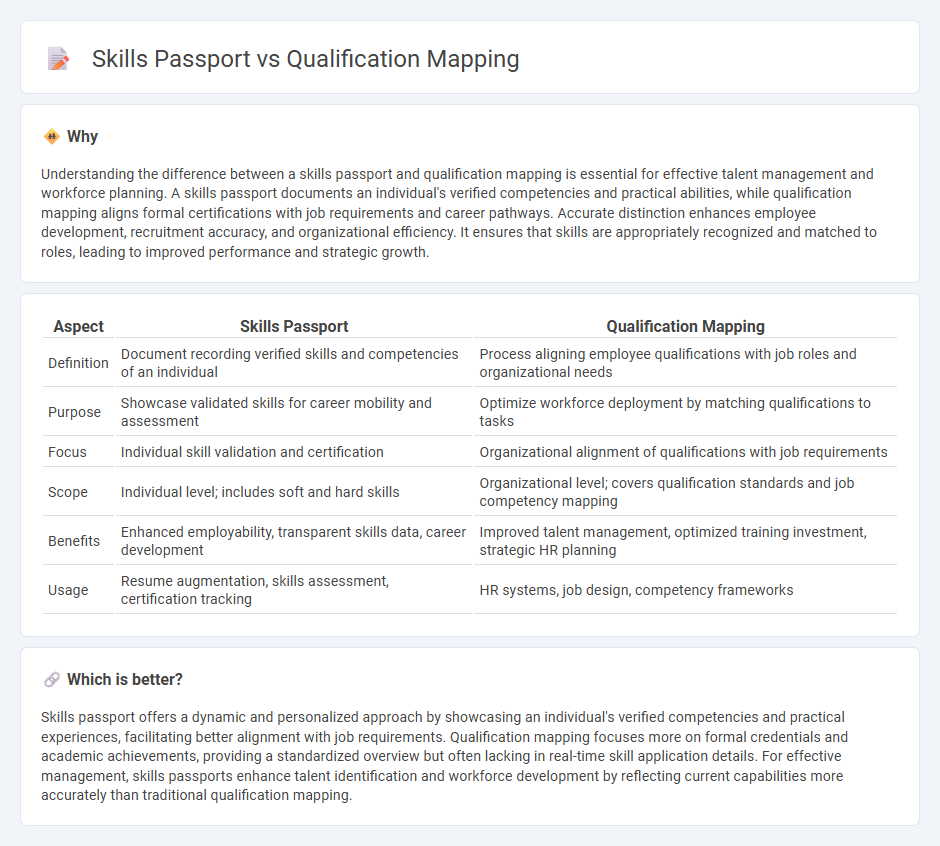
Skills passports provide a dynamic, personalized record of competencies that adapt to evolving job requirements, whereas qualification mapping aligns formal certifications with specific roles or standards within an organization. Integrating skills passports with qualification mapping enhances workforce agility by identifying skill gaps and facilitating targeted professional development. Explore how combining these tools can optimize talent management and drive organizational growth.
Why it is important
Understanding the difference between a skills passport and qualification mapping is essential for effective talent management and workforce planning. A skills passport documents an individual's verified competencies and practical abilities, while qualification mapping aligns formal certifications with job requirements and career pathways. Accurate distinction enhances employee development, recruitment accuracy, and organizational efficiency. It ensures that skills are appropriately recognized and matched to roles, leading to improved performance and strategic growth.
Comparison Table
| Aspect | Skills Passport | Qualification Mapping |
|---|---|---|
| Definition | Document recording verified skills and competencies of an individual | Process aligning employee qualifications with job roles and organizational needs |
| Purpose | Showcase validated skills for career mobility and assessment | Optimize workforce deployment by matching qualifications to tasks |
| Focus | Individual skill validation and certification | Organizational alignment of qualifications with job requirements |
| Scope | Individual level; includes soft and hard skills | Organizational level; covers qualification standards and job competency mapping |
| Benefits | Enhanced employability, transparent skills data, career development | Improved talent management, optimized training investment, strategic HR planning |
| Usage | Resume augmentation, skills assessment, certification tracking | HR systems, job design, competency frameworks |
Which is better?
Skills passport offers a dynamic and personalized approach by showcasing an individual's verified competencies and practical experiences, facilitating better alignment with job requirements. Qualification mapping focuses more on formal credentials and academic achievements, providing a standardized overview but often lacking in real-time skill application details. For effective management, skills passports enhance talent identification and workforce development by reflecting current capabilities more accurately than traditional qualification mapping.
Connection
Skills passports provide a comprehensive record of an individual's competencies, while qualification mapping aligns these competencies with specific job roles or industry standards. This connection facilitates accurate assessment, targeted training, and effective workforce planning within management frameworks. Organizations leverage this integration to enhance talent management and ensure strategic human resource development.
Key Terms
Competency Framework
Qualification mapping aligns formal certifications with industry standards within a Competency Framework, ensuring recognized validation of acquired skills. Skills passports document practical abilities and experiences, providing a dynamic, learner-centered record that complements qualification mapping by emphasizing real-world competency. Explore how integrating both approaches enhances talent development and accurate competency assessment.
Credential Verification
Qualification mapping involves aligning educational credentials with recognized standards to ensure their validity and equivalence, while skills passports provide a detailed record of acquired competencies verified by accredited institutions. Credential verification plays a critical role in both processes, ensuring authenticity and reliability of qualifications and skills documented. Explore how credential verification enhances trust and transparency in education and employment sectors.
Digital Badging
Qualification mapping aligns educational credentials with industry standards to validate competencies, while skills passports, often powered by Digital Badging, provide verified, portable records of specific skills and achievements. Digital Badging enhances skills passports by offering secure, verifiable, and shareable credentials that employers can easily assess. Explore how Digital Badging transforms qualification mapping and skills recognition for a deeper understanding.
Source and External Links
Digital Scheduling Best Practices: Qualification Mapping Essentials - Qualification mapping is the systematic process of documenting, tracking, and utilizing employee qualifications to optimize staffing decisions, involving audits, stakeholder involvement, verification protocols, and integration with existing HR systems for better scheduling and operational efficiency.
All you need to know about Validation, Qualification, and Mapping - Qualification mapping in regulated industries often refers to the examination and evaluation phase during equipment or facility qualification, particularly involving temperature mapping studies in installation, operation, and performance qualification stages to ensure compliance and operational standards.
Qualification Mapping | Try Employee Training Manager - Qualification mapping is the process of identifying and documenting specific qualifications such as education, certifications, and technical skills to manage workforce competencies effectively.
 dowidth.com
dowidth.com